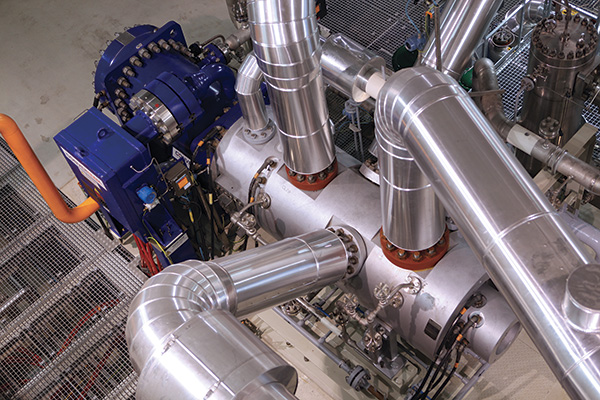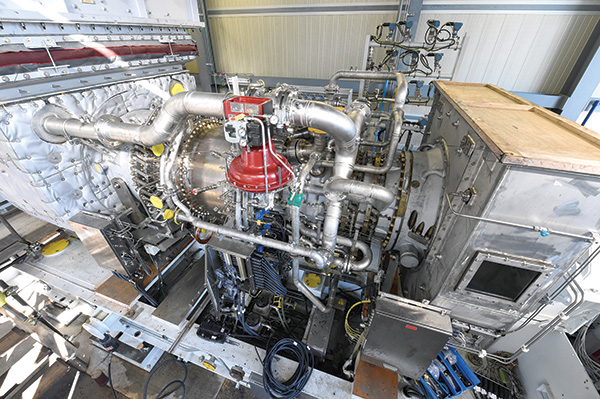November 2019, Vol. 246, No. 11
Features
How Rotating Equipment Enhances Efficiency in Pipelines
By Andrea Intieri, Pipeline Equipment Platform Leader and Maria De Renzis, Executive LNG & Pipeline Segment Leader, Baker Hughes
The quest for energy is not a new story. Over centuries, mankind has been searching for new sources of energy with economic growth and wealth as primary drivers.
According to the IEA, this trend will continue for many years to come. In fact, by 2040 primary energy demand in the “new policy” scenario is projected to rise by more than a quarter to a record level of 17,700 million tons of oil equivalent, with most of this growth coming from Asia.
However, the abundance of alternative sources of supply such as renewables are unprecedented promises to shift the traditional paradigms of economic development.
Digital technologies coupled with renewables enable more distributed, low-cost power generation. Increasing renewable power generation, forecasted to reach 40% (vs. current 25%) of the total electrical energy produced by 2040, will call for much higher grid flexibility. Solar Photovoltaic (PV) and Wind technologies are expected to continue their cost reduction trend, allowing for example PV to reach 20% of electricity generated by 2040 (more than 8,500 TWh), almost as much as the share generated by gas fired power plants.
In parallel, the shale revolution in North America enables the U.S. to dominate as an oil and gas producer and exporter. They are projected to grab half of the expected hydrocarbon production growth by 2025, breaking the historical dominance of the Middle East and Russia.
Thanks to the combination of competitive costs, abundance and lower environmental impact, gas is the hydrocarbon projected to drive the low-carbon transition, enabling a more sustainable balance over the years to come. Gas is projected to reach 25% of total primary energy demand by 2040 according to IEA. Still, more actions are needed to deploy the powerful potential of gas and to integrate its infrastructure with the power grid. Moreover, increased efficiency and reduced greenhouse gas effects will be key.
Changing World
Shifts in hydrocarbon production and consumption areas require investments in the expansion of existing transportation systems or the construction of new links, either regionally or cross-regionally. A much more interconnected global gas market, enabled by the rising trade of LNG, has deep implications on how countries plan the security of their supply and increase competition across global projects.
Today, the viability of new infrastructures is at risk unless substantial efforts are made to guarantee the highest standards of compliance with local regulations as well as controlling capital and operating expenditures. Connecting production and consumption areas often means installing the equipment in remote locations, where harsh environment and unmanned operations determine the need for high reliability, remote operability and easy maintainability.
Pipelines are valuable to their stakeholders when they can support their duty at the same time limiting as much as possible local pollution and using transported resources – namely oil, gas or refined products – by means of the most efficient compression and pumping systems.
While the best available technology approach enables safer and cleaner pipelines, today the industry must also find new paradigms to better integrate them with renewable sources. Since gas is expected to become the second largest fuel in the global energy mix by 2030, gas infrastructures will need to support energy demand increases and complement flexible renewables.
Today pipeline operators can adopt solutions to prepare for this future with the introduction of new products that enable higher flexibility.
At Baker Hughes, for example, the NovaLT gas turbine family was developed within the rotating equipment division, Turbomachinery & Process Solutions (TPS), based in Florence, Italy. In developing products for the future, TPS leverages deep knowledge and expertise in compressors and pumps as Nuovo Pignone and Thermodyn, and in gas turbines for mechanical drive and power generation built over many decades of collaboration with GE. In pipeline and storage applications alone,
Drawing on knowledge from its active fleet of more than 1,600 gas turbines and more than 2,300 compressors and pumps, TPS moved quickly from concept to serial one production of the NovaLT16. Launched at the 2014 Turbomachinery Symposium, first orders were received in 2015 and the first complete turbo-compression unit started up in a North American gas pipeline system in 2017.
The unit successfully completed a 72-hour continuous-run test in ambient temperatures down to 3° F. The unit is connected to Baker Hughes's remote monitoring and diagnostics center called the “iCenter” for 24/7 coverage.
Today, the gas turbine has accumulated more than 15,000 hours with 98.4% availability (97% utilization factor), operating within guarantees and emissions well below regulatory limits across seasonal temperature ranges from -40° F to 91° F.
Integrated Lines
Electrification is one of the most important trends in Pipeline compression equipment. Whenever access to the power grid is economically viable, operators consider electric drivers for the benefits they can bring: flexibility, reduced maintenance, lower emissions and low noise. The integrated compressor line (ICL) is a highly efficient, flexible and low noise product that pushes the boundaries of technology well beyond the traditional electric-driven compression units.
In fact, the ICL has a high-speed electric motor fully integrated with the compressor in a single sealed casing. The ICL has a high-efficiency induction motor, proven by 4 million hours of successful operation. Motor speed is regulated by a variable frequency drive (VFD).
Motor and compressors rotors are levitated by active magnetic bearings (AMB) and a precision control system, thus eliminating parts contact and wear, lube oil systems and dry gas seals — so there are no fluids to leak or dispose of, and no depressurization required on shutdown, and dramatically improve safety by limiting the risk of fire.
The AMB system also improves reliability and availability – with approximately 40% lower requested maintenance vs. conventional solutions based on oil bearings. Without auxiliaries such as the lube oil system and dry gas seal panel, there are additional benefits in terms of noise enclosure design and overall noise reduction.
The ICL features a very compact design thanks to a footprint about half that of conventional electric solutions.
The ICL compressor can either be single or multistage (with up to nine impellers) and is directly flanged onto the motor. The compressor design incorporates Baker Hughes latest technological advances, including high-performance impellers delivering the highest efficiency.
The package design is simple and has a footprint approximately half the size of a conventional compressor, allowing the installation of these solutions also in off-shore and in constrained spaces. The ICL is currently available for applications up to 21,500 Hp. The ICL fleet has on average more than 99% availability. Most of these units are operating in pipeline or storage compression stations, making it the electrical technology of choice for such applications.
Hybrid Gas Turbines
The hybrid gas turbine (HGT) architecture developed by Baker Hughes is a versatile solution with a gas turbine driving a compressor, coupled with an electrical reversible machine operating in combination. The HGT includes a VFD and a high-speed motor, in addition to the turbo-compression unit. A self-synchronizing clutch is placed between gas turbine and centrifugal compressors to run the unit in full electric (or “zero emission”) mode.
This system allows the increase of installed power without additional emissions, using power from the grid and reducing fuel consumption, which lowers emissions and increases the gas turbine life.
As an alternative, the VFD and the motor can operate as generator, producing power for the electrical grid or for compression plant self-consumption, this solution allows maintaining the gas turbine at its base load when efficiency is maximized and emissions minimized independently by the speed of the compressor drive, in this way the electrical behavior does not impact in any mode the process. The HGT can also be used as a storage system, running in full electric mode and transforming excess power from the grid into gas pressure energy, feeding a pipeline or an underground gas storage facility.
The HGT allows better integration with renewable sources, as it allows to run a pipeline and to produce power while optimizing the use of fuel in all possible operating conditions, or as a back-up of the power grid during discontinuities of renewables.
Other benefits include the increase in compression station availability when in full-electric mode, lower maintenance costs thanks to longer life of gas turbine components and the potential to expand existing facilities.
According to a study developed for a pipeline operator owning a PGT25 jet gas turbine (ISO rated at 31,700 hp), when coupled with a 13,600-hp electric motor, the system can achieve a 9% reduction in fuel and a 26% reduction in carbon footprint if operated in hybrid mode for just 3,800 hours/year. In addition, maintenance savings are generated.
The concept can be installed in greenfield or as a retrofit of existing compression stations. The HGT is therefore a promising solution for achieving better integration of gas and power grids.
Conclusions
Today, pipeline operators face increasing challenges on multiple sides, from more complex regulatory processes to the need for safer and environmentally friend operations. Baker Hughes has introduced the NovaLT gas turbine family, which is pushing the boundaries of reliability, efficiency and operability in gas turbines range up to 27,000 Hp.
As energy is transitioning toward a low-carbon future, flexibility becomes more and more important: the integration of power and gas grids can be an opportunity for the gas industry thanks to modern technologies. The integrated compressor line (ICL) and the hybrid gas turbine (HGT) help drive energy forward providing flexibility and better connecting pipeline compression stations with the power grid.
Andrea Intieri is the pipeline equipment platform leader for Baker Hughes’ Turbomachinery and Process Solutions Division

Maria De Renzis is the executive LNG and pipeline segment leader for Baker Hughes’ Turbomachinery and Process Solutions Division









Comments